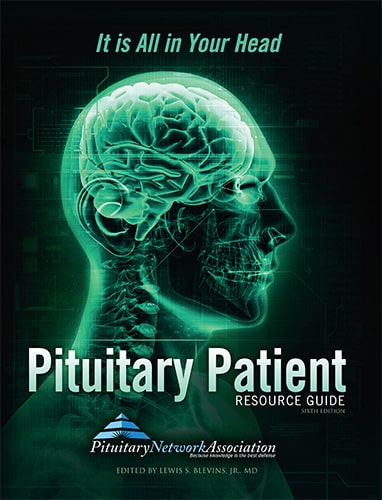News Articles February 2022
Written on 04 February 2022.
Is There A Long Recovery Process From Pituitary Tumor Surgery?
In most cases, no. Patients often report immediate relief from symptoms after Transphenoidal Hypophysectomy and little pain. Some leave the hospital the same day.
Where Do I Go To Get Tested?
It is important to go to a hospital with a Neuroendocrine Unit or Pituitary Testing Facility, preferably both. (This may necessitate plane travel, but it would be worth every penny.) Pituitary blood tests can be very complicated and must be performed by specially trained technicians who can conduct dynamic hormone testing and precisely-timed blood sampling, administer testing agents, and have special expertise in measuring pituitary hormones. Tests that require special attention include ACTH (Cortrosyn) stimulation, bilateral inferior petrosal sinus ACTH sampling, Insulin tolerance, growth hormone stimulation, TRH stimulation, GnRH stimulation, Oral glucose tolerance, and GHRH/arginine testing for growth hormone reserve.
What Is The Pituitary?
The pituitary is a small, pea-sized gland located at the base of the brain that functions as “The Master Gland.” From its lofty position above the rest of the body it sends signals to the thyroid gland, adrenal glands, ovaries and testes, directing them to produce thyroid hormone, cortisol, estrogen, testosterone, and many more. These hormones have dramatic effects on metabolism, blood pressure, sexuality, reproduction, and other vital body functions. In addition, the pituitary gland produces growth hormone for normal development of height and prolactin for milk production.
Why Are Pituitary Disorders So Hard To Diagnose?
Pituitary disorders can cause a wide spectrum of symptoms, both hormonal and neurological, due to its location near the brain, the intracranial nerves and blood vessels and because of the vital hormonal control that the gland provides. Diagnosis of pituitary disease may be extremely difficult because it’s often confused with other disorders. It is dependent on symptoms, signs on examination, blood tests and MRI findings. Direct access to the pituitary can only be reached at surgery.
Is Pituitary Tumor Surgery Risky?
Surgery is a common treatment, and it is almost always successful IF performed by a skilled and specialized neurosurgeon. The smaller the tumor, the greater the chance the surgery will be successful. Large tumors that grow upward (into the nerves that mediate vision) or laterally (into the cavernous sinuses that contain the major arteries to the brain-the carotid arteries) increase the risk of surgery and are generally associated with a lower probability of cure. Early diagnosis and treatment is the key.
Which Hormones Are Produced And/Or Controlled By The Posterior Pituitary Or Hypothalamus?
- Oxytocin stimulates contractions of the uterus during labor and the ejection of milk during breast-feeding.
- Antidiuretic Hormone (ADH) increases reabsorption of water into the blood by the kidneys and therefore decreases urine production. Also referred to as Vasopressin.
How Do I Get Diagnosed?
Anyone suffering from a constellation of complaints/clinical findings suspicious for pituitary disease should get blood and urinary hormone levels checked and, if indicated, a brain MRI, keeping in mind that microadenomas may not show up on the x-rays. Combinations of three or more of the following may suggest the possibility of a pituitary tumor: sexual dysfunction, depression, galactorrhea, infertility, growth problems, osteoporosis, obesity (specifically central), severe vision problems, easy bruising, aching joints, carpel tunnel syndrome, disrupted menses, early menopause, muscle weakness, fatigue.
Why Are These Tumors So Common?
We don’t know because funding for benign brain tumor research is virtually nonexistent. That’s about to change. In October 2002, Congress passed the Benign Brain Tumor Cancer Registries Amendment Act, which will force hospitals, clinics and doctors to report pituitary tumor incidence rates in the data collection of cancer registries. The problem remains diagnosis. No report of incidence rates is possible without it.
Why Are Mental Health Symptoms Connected With Pituitary Disorders?
This is a complex and not completely understood area of pituitary medicine. Of course it is very logical and reasonable for anyone who has physical limitations, pain, discomfort to feel sad about a loss or change in their body functioning. Depression, which is different than sadness, is cited as a component of many chronic and/or serious physical illnesses. But pituitary disorders have a unique relationship with mental and emotional states. The chemistry of how such hormones as Prolactin and Cortisol act upon the brain is thought to either directly or indirectly causes psychological problems. There is also evidence linking emotional trauma, especially early in life, to later development of pituitary/Neuroendocrine disorders. Emotional factors are also known to affect the immune system. Thyroid hormones are also known to affect brain function and behavior and sensitive to environmental factors that cause stress. Therefore, a combination of stressful life events combined with a persons unique vulnerabilities and the powerful forces of certain hormones seem to commonly bring pituitary tumors and other Neuroendocrine disorders together with mental and emotional disturbances.
What Happens After A Tumor Is Removed/Treated?
There may be permanent loss of some or all pituitary hormones, an imbalance that can be treated with Hormone Replacement Therapy, which has been inaccurately associated with only one group of patients: post-menopausal women. HRT can replace thyroid, growth, testosterone, or adrenal hormones when those made by the pituitary to stimulate the endocrine glands are no longer produced. It can be lifesaving therapy for the many millions of patients who need to replace hormones they no longer make.
Available Now!

The Pituitary Patient Resource Guide Sixth Edition is now available! Be one of the first to have the most up-to-date information. The Pituitary Patient Resource Guide a one of a kind publication intended as an invaluable source of information not only for patients but also their families, physicians, and all health care providers. It contains information on symptoms, proper testing, how to get a diagnosis, and the treatment options that are available. It also includes Pituitary Network Association's patient resource listings for expert medical care.








